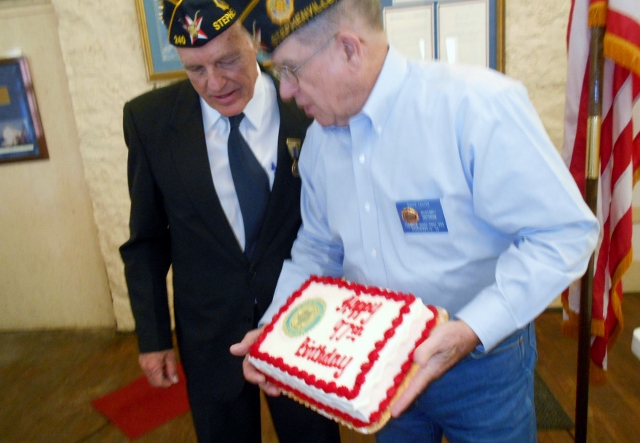
Commander Burton Smith (L) joins Post 240 adjutant Roger Easter in presenting birthday cake to membership & guest attending the regular third Tuesday meeting on March 15, 2016.
On this date in 1919, members of the American Expeditionary Force convened in Paris for the first American Legion caucus. In May of 1919, at a St. Louis, MO. Caucus, "The American Legion" is adopted as the organization's official name. The Legion's draft preamble and constitution are approved. On June 9, 1919 The National Executive Committee adopts the Legion emblem and on September 16, 1919 Congress charters The American Legion. On November 11, 1919 the First Legion convention convenes in Minneapolis. The Constitution and preamble are adopted. Delegates vote 361-323 to locate the Legion's national headquarters in Indianapolis, instead of Washington.
The American Legion was chartered by Congress in 1919 as a patriotic veterans organization. Focusing on service to veterans, service members and communities, the Legion evolved from a group of war-weary veterans of World War I into one of the most influential nonprofit groups in the United States. Membership swiftly grew to over 1 million, and local posts sprang up across the country. Today, membership stands at over 2.4 million in 14,000 posts worldwide. The posts are organized into 55 departments: one each for the 50 states, along with the District of Columbia, Puerto Rico, France, Mexico and the Philippines.
Over the years, the Legion has influenced considerable social change in America, won hundreds of benefits for veterans and produced many important programs for children and youth. Following are a few significant programs implemented by the American Legion. The complete list in chronological order can be found at www.legion.org ;
Aug. 9, 1921- The Legion's efforts result in the creation of the U.S. Veterans Bureau, forerunner of the Veterans Administration; June 15, 1923- The first "Flag Code" is drafted during a Legion conference in Washington. Congress adopts the code in 1942. Today, the Legion is at the forefront of efforts to pass a constitutional amendment to protect the U.S. flag from physical desecration; Dec. 15, 1943- Past National Commander Harry W. Colmery starts to write in longhand, on Mayflower Hotel stationery in Washington, the first draft of what will later become the "GI Bill of Rights" – considered the Legion's single greatest legislative achievement; June 22, 1944- President Franklin D. Roosevelt signs into law the original GI Bill, or Servicemen's Readjustment Act, ushering in monumental changes in U.S. society. Higher education becomes democratized after 8 million veterans go to school on the GI Bill, get better jobs, buy houses in the suburbs and raise families. For every dollar spent on educating veterans, the U.S. economy eventually gets $7 back.
